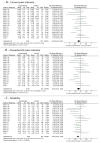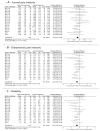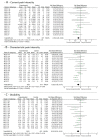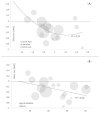Motor Control Stabilisation Exercise for Patients with Non-Specific Low Back Pain: A Prospective Meta-Analysis with Multilevel Meta-Regressions on Intervention Effects
- PMID: 32971921
- PMCID: PMC7564352
- DOI: 10.3390/jcm9093058
Motor Control Stabilisation Exercise for Patients with Non-Specific Low Back Pain: A Prospective Meta-Analysis with Multilevel Meta-Regressions on Intervention Effects
Abstract
Low-to-moderate quality meta-analytic evidence shows that motor control stabilisation exercise (MCE) is an effective treatment of non-specific low back pain. A possible approach to overcome the weaknesses of traditional meta-analyses would be that of a prospective meta-analyses. The aim of the present analysis was to generate high-quality evidence to support the view that motor control stabilisation exercises (MCE) lead to a reduction in pain intensity and disability in non-specific low back pain patients when compared to a control group. In this prospective meta-analysis and sensitivity multilevel meta-regression within the MiSpEx-Network, 18 randomized controlled study arms were included. Participants with non-specific low back pain were allocated to an intervention (individualized MCE, 12 weeks) or a control group (no additive exercise intervention). From each study site/arm, outcomes at baseline, 3 weeks, 12 weeks, and 6 months were pooled. The outcomes were current pain (NRS or VAS, 11 points scale), characteristic pain intensity, and subjective disability. A random effects meta-analysis model for continuous outcomes to display standardized mean differences between intervention and control was performed, followed by sensitivity multilevel meta-regressions. Overall, 2391 patients were randomized; 1976 (3 weeks, short-term), 1740 (12 weeks, intermediate), and 1560 (6 months, sustainability) participants were included in the meta-analyses. In the short-term, intermediate and sustainability, moderate-to-high quality evidence indicated that MCE has a larger effect on current pain (SMD = -0.15, -0.15, -0.19), pain intensity (SMD = -0.19, -0.26, -0.26) and disability (SMD = -0.15, -0.27, -0.25) compared with no exercise intervention. Low-quality evidence suggested that those patients with comparably intermediate current pain and older patients may profit the most from MCE. Motor control stabilisation exercise is an effective treatment for non-specific low back pain. Sub-clinical intermediate pain and middle-aged patients may profit the most from this intervention.
Keywords: LBP; chronic low back pain; exercise; lumbago; lumbalgia; meta-analysis; motor control exercise; nonspecific; sensorimotor; stabilization; unspecific low back pain.
Conflict of interest statement
The authors declare no conflict of interest.
Figures





Similar articles
-
Sustainability effects of motor control stabilisation exercises on pain and function in chronic nonspecific low back pain patients: A systematic review with meta-analysis and meta-regression.PLoS One. 2020 Jan 15;15(1):e0227423. doi: 10.1371/journal.pone.0227423. eCollection 2020. PLoS One. 2020. PMID: 31940397 Free PMC article.
-
Motor control exercises reduces pain and disability in chronic and recurrent low back pain: a meta-analysis.Spine (Phila Pa 1976). 2013 Mar 15;38(6):E350-8. doi: 10.1097/BRS.0b013e31828435fb. Spine (Phila Pa 1976). 2013. PMID: 23492976
-
Yoga Treatment for Chronic Non-Specific Low Back Pain (2017).Explore (NY). 2017 Jul-Aug;13(4):281-284. doi: 10.1016/j.explore.2017.04.018. Epub 2017 Apr 22. Explore (NY). 2017. PMID: 28688789
-
Dose-response-relationship of stabilisation exercises in patients with chronic non-specific low back pain: a systematic review with meta-regression.Sci Rep. 2020 Oct 9;10(1):16921. doi: 10.1038/s41598-020-73954-9. Sci Rep. 2020. PMID: 33037280 Free PMC article.
-
Pain and Disability Therapy with Stabilization Exercises in Patients with Chronic Low Back Pain: A Meta-Analysis.Healthcare (Basel). 2025 Apr 22;13(9):960. doi: 10.3390/healthcare13090960. Healthcare (Basel). 2025. PMID: 40361738 Free PMC article. Review.
Cited by
-
Psychosocial Moderators and Mediators of Sensorimotor Exercise in Low Back Pain: A Randomized Multicenter Controlled Trial.Front Psychiatry. 2021 Jul 29;12:629474. doi: 10.3389/fpsyt.2021.629474. eCollection 2021. Front Psychiatry. 2021. PMID: 34393840 Free PMC article.
-
The effect and mechanism of motor control exercise on low back pain: a narrative review.EFORT Open Rev. 2023 Jul 3;8(7):581-591. doi: 10.1530/EOR-23-0057. EFORT Open Rev. 2023. PMID: 37395680 Free PMC article.
-
Ultrasound Imaging as a Visual Biofeedback Tool in Rehabilitation: An Updated Systematic Review.Int J Environ Res Public Health. 2021 Jul 15;18(14):7554. doi: 10.3390/ijerph18147554. Int J Environ Res Public Health. 2021. PMID: 34300002 Free PMC article.
-
Effect of Six-Week Resistance and Sensorimotor Training on Trunk Strength and Stability in Elite Adolescent Athletes: A Randomized Controlled Pilot Trial.Front Physiol. 2022 Mar 17;13:802315. doi: 10.3389/fphys.2022.802315. eCollection 2022. Front Physiol. 2022. PMID: 35370766 Free PMC article.
-
Sensorimotor Stabilization Exercises With and Without Behavioral Treatment in Low Back Pain: Feasibility and Effects of a Multicenter Randomized Controlled Trial.Arch Rehabil Res Clin Transl. 2025 Jan 27;7(1):100430. doi: 10.1016/j.arrct.2025.100430. eCollection 2025 Mar. Arch Rehabil Res Clin Transl. 2025. PMID: 40463774 Free PMC article.
References
LinkOut - more resources
Full Text Sources
Miscellaneous

